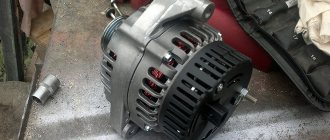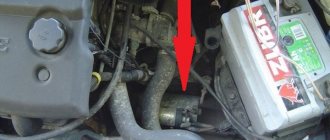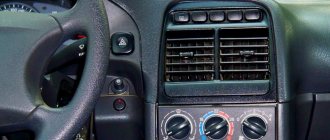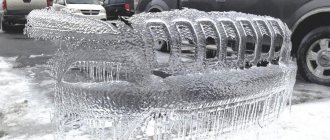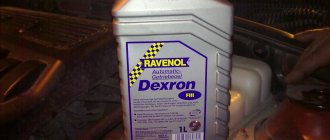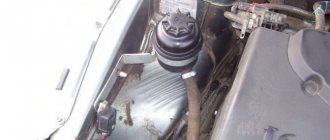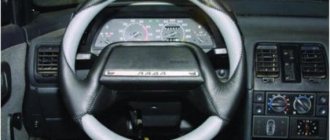Power steering is designed to make driving easier without losing “road feel” - feedback between the steering wheels and the steering wheel.
Also, the use of these units made it possible to reduce the gear ratio on the steering mechanism - the number of turns of the steering wheel from lock to lock, which also affected the ease of control.
Several types of such devices are used in vehicles, but the most widespread is hydraulic power steering - power steering.
The unit performs its function by creating fluid pressure on the steering rack, which creates additional force to move it.
The main purpose of power steering is to increase the convenience of driving a car, but this unit also has a positive effect on traffic safety, but only if the amplifier fully performs its assigned functions.
Design and operating principle
To quickly find the reasons for the buzzing of the power steering, you need to understand its structure and operating principle.
Structurally, the power steering is very simple and includes the following main components:
- Pump;
- Distributor;
- Working cylinder;
- Pipelines (high and low pressure);
There are several design versions of the unit, but on passenger cars power steering is used, in which the distributor and working cylinders are integrated into the steering mechanism.
In this design, the distributor is connected to the steering column shaft, the mechanism body acts as a cylinder, and its piston is mounted on a rack. The working element of the mechanism is a special oil.
The principle of operation of the power steering is as follows: the pump constantly pumps oil, creating pressure in the system, from which it flows through the high pressure line to the distributor.
If the wheels are level while driving, then the working fluid from the distributor through the low-pressure line returns back to the pump, that is, it constantly circulates in a circle.
When the steering wheel is turned, the steering column shaft moves the distributor spool, thereby opening the fluid supply channel into the desired cylinder cavity.
The oil, having filled this cavity, begins to put pressure on the piston, thereby helping the rack to move. When the steering wheel stops rotating, the spool immediately moves to the neutral position and the fluid stops acting on the rack.
A simplified circuit is described above, which is sufficient for a general understanding of the operating features of the amplifier.
READ MORE: Steering control, structure and principle of operation.
Liquid gone
Perhaps the simplest thing is when the fluid leaves the power steering reservoir, that is, its normal level drops. Let me remind everyone that a special ATF fluid , the same as is poured into automatic transmissions (automatic transmissions). If the liquid leaves, then the pump works in the air space and hums.
We urgently need to add ATF and figure out why it left, it could simply ruin the pump.
The power steering is humming, we are looking for the reasons
The service life of the hydraulic booster is significant; it can work for up to 200 thousand km without problems, but if it is serviced in a timely manner. service.
At the same time, power steering is a mechanism consisting of components that are complex in design, so malfunctions in it also happen. One of them is buzzing.
This is a common problem that can occur on any car equipped with this unit. In addition to sound, the malfunction is often accompanied by additional symptoms - the force on the steering wheel increases, and vibration may occur.
The power steering can hum under different conditions - only when “hot” or “cold”, constantly, or when the wheels are turned to extreme positions.
Since third-party sounds can appear in any car attachment, you first need to make sure that the amplifier is their source. This is easy to establish - by the changing tone of the sound when you turn the steering wheel.
The hum in this mechanism can only be produced by one component - the pump, but there are several reasons why this happens.
The appearance of sound so far only signals the occurrence of problems in the operation of the entire mechanism, and not its failure. But if you do not take measures, then eventually a breakdown will occur - the pump will break. At the same time, this unit is expensive, so it is easier to eliminate a malfunction that causes a humming noise even before the element breaks than to purchase a new pump to replace it.
Often the cause of buzzing in the power steering is the working fluid, or more precisely:
- Its level falls below a critical level;
- Incorrect oil brand;
- Using counterfeit liquid;
- The service life of the working fluid is exhausted or it is severely contaminated.
For the most part, the consequences of these reasons are the car owner’s desire to save money (purchase of cheap oils) or ignoring the rules for carrying out maintenance of the amplifier.
The second common cause of power steering hum is air getting inside the system. And air jams occur either due to improper replacement of the working fluid, or when leaks appear at the junctions of pipelines and seals of units.
The third reason is technical, and it includes natural wear and tear of the amplifier components - pump or hydraulic cylinder, or installation of defective elements that do not meet operating conditions, or loosening of the drive belt.
Common causes of sound
In each specific case - buzzing “cold” or “hot”, there are specific reasons for this phenomenon.
The appearance of sound in any conditions can occur when the level of the working fluid drops, the pump bearings wear out and the drive belt becomes loose. In this case, the power steering will buzz constantly.
In the case of bearing wear, the mechanism does not suffer any particular harm, the only thing is that the load on the belt increases, since it becomes more difficult to turn the pump rotor. To solve the problem, it is enough to replace the bearings.
Power steering operation with a small amount of oil has significantly worse consequences. Under such operating conditions, the components of the pump wear out very intensively and the service life of the unit is greatly reduced. And the longer the system operates with a lack of fluid, the more serious the consequences will be.
Here, before refilling the level, you first need to establish why it fell and eliminate the breakdown (and this can happen due to a rupture of pipelines, wear of the oil seals and seals of the pump, hydraulic cylinder). Only after this we restore the oil level and pump the system.
A loose belt will cause it to slip on the pulleys, usually accompanied by a loud buzzing or squealing noise. At the same time, the performance of the amplifier drops, and it does not fully perform its functions, which is accompanied by an increase in effort or the appearance of steering wheel beating.
Drive unit
The next reason is the drive of the mechanism. The hydraulic booster is driven by the crankshaft pulley. The nodes are connected by a belt drive. It should have good tension. Otherwise, the pump pressure will be insufficient. In addition to the hum, you will feel that the steering wheel has begun to turn much more tightly, and in addition there will be increased vibration. Check the condition of the belt.
Adjust the position of the tension roller. Typically, a 14mm wrench is used for such work. Also check the condition of the belt itself. Of course, if it breaks, the valves will not bend, as on the timing belt. The pump will simply stop producing pressure. However, you should not drive with a cracked belt. If the element has burrs and small cracks, it needs to be replaced. At the same time, check the condition of other belts (alternator and timing gear) that are located nearby.
Check how the belt bearing rotates: it should not whistle. If so, replace the element with a new one.
Rumbling when cold
If after starting the engine you hear a distinct hum (the power steering is not warmed up and is running cold), the problem often lies in air getting inside the system.
To verify this, just look into the power steering reservoir - if there is air in the fluid, the oil will bubble and foam quite strongly.
Air is removed by pumping, but before that you need to establish how it got into the system.
To do this, inspect all pipeline connections for signs of leakage. Where even the slightest traces of leaks are found, the clamps should be tightened.
It is imperative to check the tightness of the clamp of the oil supply tube from the tank to the pump, even if there are no signs of leakage on it. Often it is in this place that air leaks occur, which causes a buzzing sound in the power steering.
Sometimes, to eliminate the hum, it is enough just to replace this pipeline and install two clamps at the connection points.
Air can enter the system not only at the connections, but also through the seals of the pump and steering mechanism. Over time, they lose their elasticity, crack and cease to perform their functions. The problem with humming in this case is solved by installing new rubber elements.
READ ON THE TOPIC: Power steering malfunctions.
Noisy when warm
When a buzzing sound occurs “on hot,” the source of the problem usually lies in the liquid. In this case, you first need to check its level and condition. The drop in level is described above, but the condition of the oil needs to be sorted out.
The performance of power steering largely depends on the viscosity of the working fluid. If the oil is not viscous enough, it will be more difficult for the pump to create the necessary pressure.
Over time, the oil loses its properties, including viscosity. After heating, it becomes too liquid, so the pump simply cannot create the required pressure. All this is accompanied by a buzzing sound and a heavier steering wheel.
The same can happen if the system is filled with oil that does not match the brand or is completely counterfeit. In this case, the liquid simply cannot perform its functions.
Another reason for the appearance of a buzzing sound when “hot” is wear of the components due to a large amount of dirt in the oil. Due to wear on the working surfaces, the required seal between them is not achieved and pressure losses occur. If the pump is worn out, some of the liquid will flow inside it and it will not be able to create the required pressure.
IMPORTANT TO KNOW: How to change power steering oil.
But humming can occur not only due to exhaustion in the pump, but also due to wear of the working cylinder and piston mounted on the rack. Due to the depletion in this unit, during power steering operation, liquid will flow from cavity to cavity through leaks, ensuring a pressure drop.
Restoring the functionality of the power steering and eliminating the buzzing sound “on hot” depends on the cause of its occurrence. If the inspection reveals severe darkening of the oil, it should definitely be replaced, preferably with flushing the system and replacing the tank.
As for the tank, it has a dirt-collecting mesh installed in it, which becomes heavily clogged over time, so this element should be changed when changing the oil, especially if it is dirty.
But some people get by with high-quality flushing of the tank. For replacement, you should use fluids recommended by the car manufacturer.
Wear on the components of the amplifier is eliminated by replacing the components. But since the cost of the pump or steering mechanism is significant, you can try to extend the service life by carrying out repairs using repair kits.
Replacing seals, seals, and bearings quite often helps solve the problem with power steering buzzing. Another inexpensive option is to fill the system with oil with high viscosity. Such a liquid, even after heating, will remain dense enough for a worn pump to create the necessary pressure.
Other cases
Many drivers note that the power steering hums when the steering wheel is turned to extreme positions. But in this case, the increased sound of the device is normal, since the pump in this position of the wheels works at maximum capacity to provide the required pressure.
If it is noted that the buzzing is very loud, then the reasons should be looked for in the same place as when the “hot” sound appeared, that is, first of all you need to check the level and quality of the liquid.
It happens that a humming noise appears after maintenance work - changing the oil, changing lines, etc.
Here the reason may lie in insufficient pumping of the system (air remains in it), poor quality of the installed part or weak tightening of its fastening (air is sucked in) or inconsistency of the fluid.
IMPORTANT TO KNOW: How to repair a car's steering.
Grinding, as well as squeaking (the steering wheel turns both when driving and when standing still)
A grinding/creaking sound that is felt when the steering wheel is turned in different directions. This noise occurs due to wear on the suspension joints or steering joints. Similar to the previous point, here you will need to diagnose the suspension components or steering system, replacing worn parts, if necessary.
However, the most common reason for such a sound is the lack of lubrication in the steering tips (as well as their severe wear).
Sometimes such a squeak can even be accompanied by a crunching sound, regardless of whether the car is moving or standing still. In this case, the culprits are the lower ball joints (sometimes the shock strut bearings). The first option is also accompanied by play in the steering wheel when the car is suspended.
Correct operation and maintenance
To reduce the likelihood of a problem such as power steering buzzing, you should follow several rules:
- Change the oil in a timely manner (approximately this should be done every 80-100 thousand km or every 2 years. But if the car is used very intensively, then the replacement frequency should be reduced to 60-70 thousand km);
- Periodically check the level and condition of the fluid. Timely topping up and eliminating the cause of the leak will prevent air from entering the system;
- Do not hold the wheels in the extreme position for more than 5 seconds. Operating the pump at maximum load leads to intense wear, and there is also a possibility of lines breaking due to excessive pressure;
- Do not turn the steering wheel immediately after starting the engine. Engaging the power steering immediately after starting the engine results in the system operating under increased load. It is better to give time for the pump to “drive” the oil around, warming it up a little and reducing the viscosity;
- When parking the car, the wheels should only be set straight. In this position, after starting the engine, the pump will operate with minimal load;
- Monitor the condition of the steering mechanism and promptly change boots and seals. This will protect the unit from leaks.
All these measures will not only reduce the likelihood of buzzing, but also generally extend the service life of the power steering.
How to remove air from the power steering
If the power steering hums due to air getting into the oil, there is a very simple way to get rid of the problem:
- Start the car and let the engine idle for 5 minutes.
- Turn the steering wheel all the way to the right, leave it in this position for 5-7 seconds.
- Repeat the same, turning the steering wheel all the way to the left.
After several repetitions of this procedure, air usually leaves the power steering circuit. However, this method does not always work, so the hydraulic booster often has to be disassembled. For this:
- Disconnect the return hose from the tank, plug the hole with a stopper made of waterproof material or a special plug.
- Place the disconnected end of the hose into a clean container.
- Start the engine and begin to turn the steering wheel until the power steering pump begins to pump out power steering oil.
This procedure is repeated until foamed liquid stops flowing from the system - clean oil should appear.
Features of power steering of some cars
Since the design of power steering on different cars is very similar, the reasons for the appearance of a hum on the same GAZelle or Chevrolet Cruze are identical. But here it is worth taking into account the design features of the amplifiers. Some models have their own unusual power steering “diseases”.
For example, on a Chevrolet Cruze, high-pressure lines can produce a hum (according to one version, due to insufficient throughput).
These lines run along the radiator, to which they are attached through rubber bushings. But these bushings are not enough to dampen the vibrations that are the source of the hum. And the problem in this case is solved by placing an additional rubber spacer under the bushings.
But on the UAZ “Loaf” the hum of the amplifier is often a consequence of the strong heating of the oil during operation. Sometimes the owners of this car are helped by filling with a more viscous liquid. But some craftsmen solve the problem by installing a radiator for the power steering - they simply cut an additional metal tube into the system, which provides additional cooling of the oil.
And such features are present in almost every car - VAZ Priora, Cherry Amulet, Ford Focus, but the main reasons for the hum are still air ingress, oil not meeting operating conditions and wear of components.
Finally, we note that if the power steering is humming, you should not delay repairs, since this is a signal of problems in the operation of the unit, which can develop into a complete failure of it, and this already threatens loss of control of the car.
